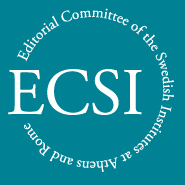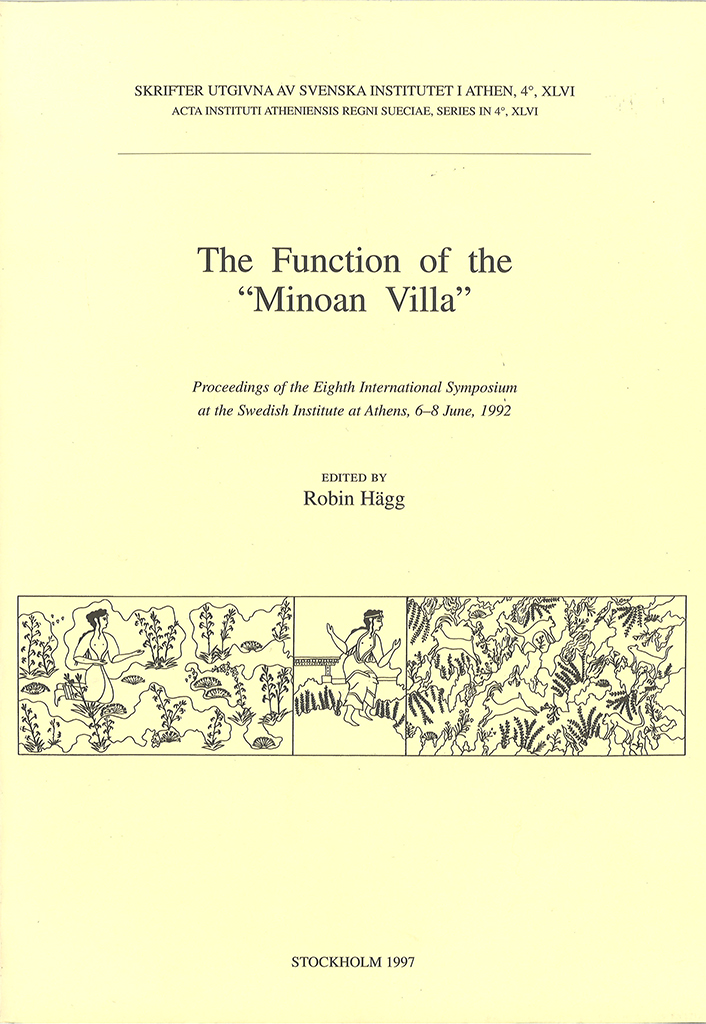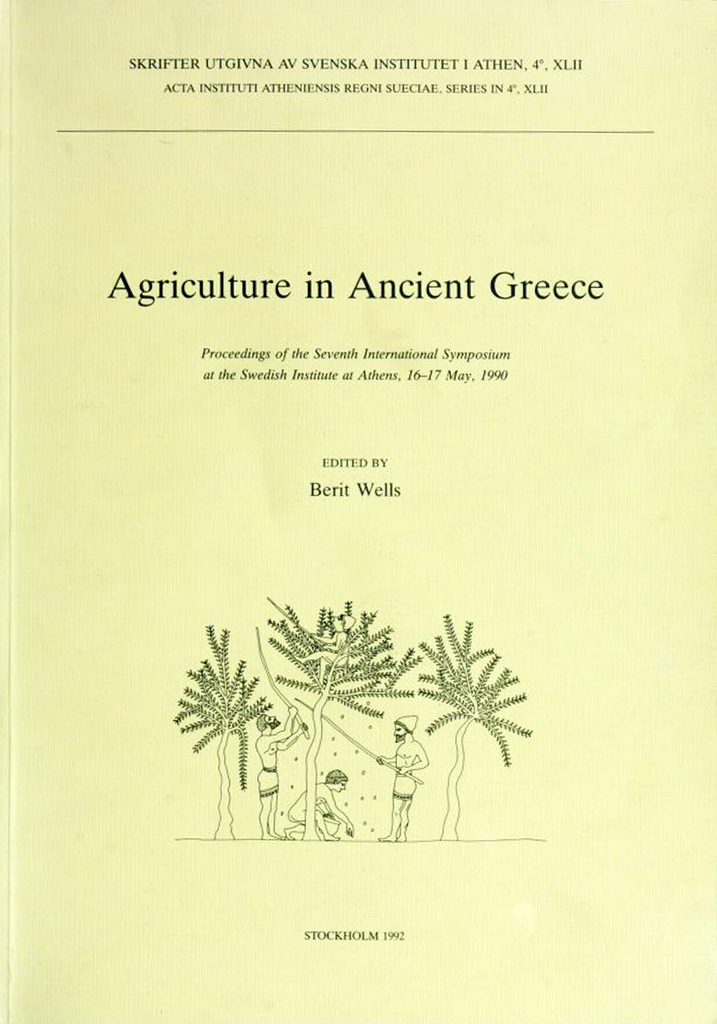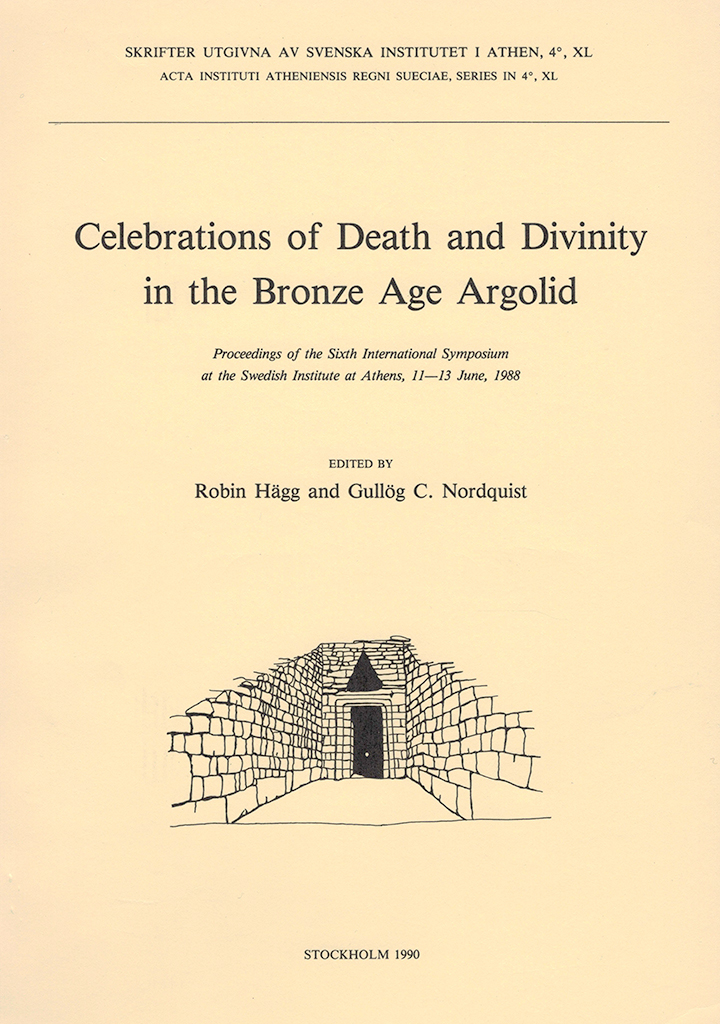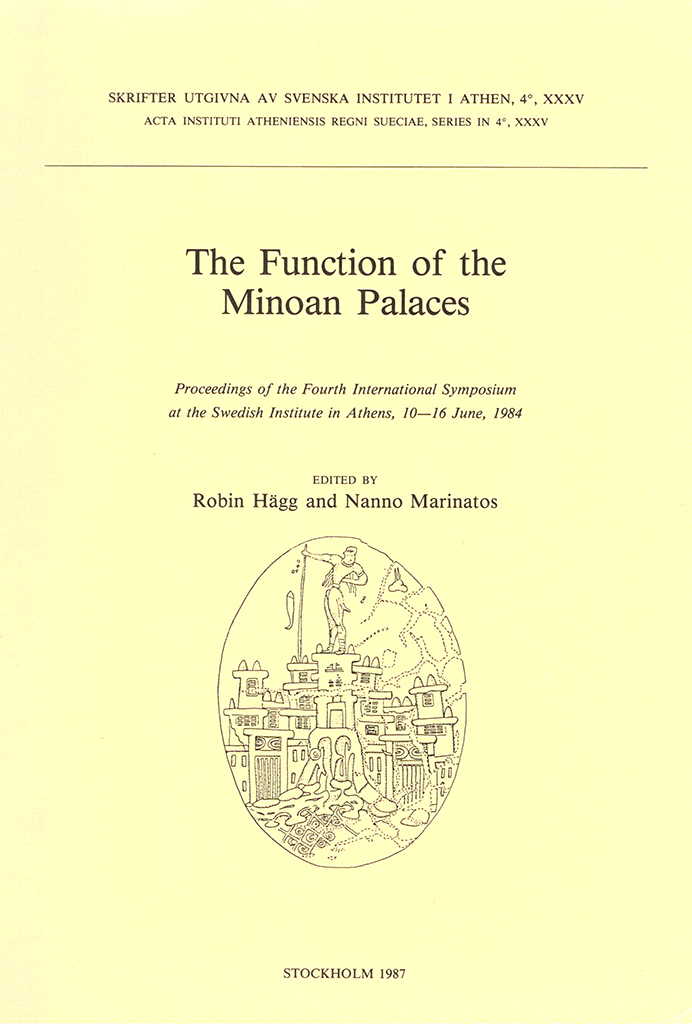Published by the Swedish Institute at Athens. Distributed by Astrom Editions. Peloponnesian sanctuaries and cults. Proceedings of the Ninth International Symposium at the Swedish Institute at Athens, 11–13 June 1994 Edited by Robin Hägg Abstract A collection of twenty-six papers read (or presented as posters) at an international symposium in Athens that dealt with various aspects of the ancient sanctuaries and cults in the Peloponnese, based on literary, iconographical and archaeological evidence. Among the special topics discussed are a newly excavated, Mycenaean sanctuary at Methana, the formation of sacred landscapes, Corinthian cult in the Late Geometric period, sacred places in early urban contexts (Argos), caves and cults at Isthmia, cults of Demeter and Kore, the sanctuary of Hera Akraia at Perachora, the Herakleidai in the Argive plain, the Archaic and Hellenistic temples at Mycenae, cult places in Argos, cults of Athena in Argos, mountain-top cults in Corinthia and the Argolid, new investigations of small cult buildings in the Asklepieion of Epidauros, results of recent work in the sanctuary of Athena Alea at Steges, Herakles and healing cults, sanctuaries of Artemis in the Peloponnese, the reality of the human sacrifices on Mr. Lykaion, the new excavation in the sanctuary of Zeus…
Published by the Swedish Institute at Athens. Distributed by Astrom Editions. The function of the “Minoan villa”. Proceedings of the Eight International Symposium at the Swedish Institute at Athens, 6–8 June, 1992 Edited by Robin Hägg Abstract These twenty papers, presented at an international conference in Athens, deal with various aspects of the so-called villas in Neopalatial Crete and their possible predecessors or equivalents in the preceding, Protopalatial period. They are followed by transcripts of the discussions of the symposium. Among the problems treated are: the origin of the “villa system”, the definition of the “villa”, the architectural analysis of buildings and building complexes, the magico-religious background of the “villa”, the role of religious painting, the origin of the Cretan andreion, and a study of ceramic exchange between towns and outlying settlements in Neopalatial eastern Crete. Special discussions concern the functional analysis of the architecture, administration and bureaucracy, with special reference to seals, sealings and Linear A tablets and political geography. Contents ‘Preface’, p. 7. Henri van Effenterre & Micheline van Effenterre, ‘Towards a study of Neopalatial “villas”: modern words for Minoan things’, pp. 9–13. Wolf-Dietrich Niemeier, ‘The origins of the Minoan “villa” system’, pp. 15–19. J.A. MacGillivray, ‘The Cretan…
Published by the Swedish Institute at Athens. Distributed by Astrom Editions. Agriculture in ancient Greece. Proceedings of the Seventh International Symposium at the Swedish Institute at Athens, 16–17 May 1990 Edited by Berit Wells Abstract These fourteen papers on ancient Greek agriculture were read, or emanated from the discussions during, an international conference in Athens; the papers are followed by transcripts of the discussions of the symposium. Two main themes are addressed: (1) production—how do we recognize a farm and what could be, and what was, produced on it? (2) and the organization of agriculture—who owned the land, who worked it and how, and how much did it yield? Contents Preface Jens Erik Skydsgaard, ‘Agriculture in ancient Greece. On the nature of the sources and the problems of their interpretation’, pp. 9–12. Eberhard Zangger, ‘Prehistoric and historic soils in Greece: Assessing the natural resources for agriculture’, pp. 13–18. Robin Osborne, ‘‘Is it a farm?’ The definition of agricultural sites and settlements in ancient Greece’, pp. 21–25. Hans Lohmann, ‘Agriculture and country life in Classical Attica’, pp. 29–57. ‘Discussion after first section on production’. Anaya Sarpaki, ‘The Paleoethnobotanical approach. The Mediterranean triad or is it a quartet?’, pp. 61–75. Marie-Claire Amouretti,…
Published by the Swedish Institute at Athens. Distributed by Astrom Editions. Celebrations of death and divinity in the Bronze Age Argolid. Proceedings of the Sixth International Symposium at the Swedish Institute at Athens, 11–13 June, 1988 Edited by Robin Hägg & Gullög C. Nordquist Abstract Twenty-four papers on various aspects of burial customs and religious cult practice in the region Argolis (Greece) during the Bronze Age, read at an international conference in Athens; the papers are followed by transcripts of the discussions of the symposium. The papers are arranged in six groups, discussing (1) ceremonial practices in the Early and Middle Helladic periods, (2) mortuary customs, state formation and Mycenaean society, (3) burial rites in tumuli, tholoi and chamber tombs, (4) symbols and symbolism in Mycenaean celebrations, (5) Mycenaean cults and cult practices, and (6) religious aspects of the post-Bronze-Age period. Contents Preface (p. 7) Ceremonial practices in the Early and Middle Helladic periods Daniel J. Pullen, ‘Early Helladic burials at Asine and Early Bronze Age mortuary practices’, pp. 9–12 Miriam Caskey, ‘Thoughts on Early Bronze Age hearths’, pp. 13–21 Carol Zerner, ‘Ceramics and ceremony: Pottery and burials from Lerna in the Middle and early Late Bronze Ages’, pp. 23–34…
Published by the Swedish Institute at Athens. Distributed by Astrom Editions. Early Greek cult practice. Proceedings of the Fifth International Symposium at the Swedish Institute at Athens, 26-29 June, 1986 Edited by Robin Hägg, Nanno Marinatos & Gullög C. Nordquist Abstract Twenty-eight papers on the phenomena of early Greek cult practice, concentrating on the Late Geometric, Archaic and Classical periods, read at an international conference in Athens; the papers are followed by transcripts of the discussions of the symposium. The papers are arranged in eight groups, discussing (1) animal sacrifice, Minoan to Greek, (2) Greek sacrificial ritual, (3) early cults at Knossos and Sparta, (4) temples, altars, cult images and ritual meals, (5) water in the cult, (6) votive offerings, (7) cult practice and cultural anthropology, and (8) special cults and cult practices (including cults of heroes, veneration of ancestors, ritual haircuts and building sacrifices). Bibliographical information Robin Hägg, Nanno Marinatos & Gullög C. Nordquist, eds, Early Greek cult practice. Proceedings of the Fifth International Symposium at the Swedish Institute at Athens, 26-29 June, 1986 (Skrifter utgivna av Svenska institutet i Athen, 4°, 38), Jonsered 1988. ISSN 0586-0539. ISBN 9789185086979. Alternative series title: Acta Instituti Atheniensis Regni Sueciae series in 4˚,…
Published by the Swedish Institute at Athens. Distributed by Astrom Editions. The function of the Minoan palaces. Proceedings of the Fourth International Symposium at the Swedish Institute in Athens, 10–16 June, 1984 Edited by Robin Hägg & Nanno Marinatos Abstract Fourty-seven papers on the functions of the palace, the most characteristic phenomenon of the Minoan Bronze Age civilization in Crete, read at an international conference in Athens; the papers are followed by transcripts of the discussion of the symposium. The papers are arranged in eight groups, discussing (1) background (Near Eastern and Egyptian economy), parallels (Mycenaean palaces) and methodology; (2) the emergence of the Cretan palaces; (3) the relations of the palace with town and territory; (4) recent archaeological finds; (5) the palaces as ceremonial and religious centres; (6) the palaces as centres of trade and manufacture; (7) the administrative systems of the Minoans and Mycenaeans; and (8) the function of the frescoes in the palace. For James Walter Graham and to the memory of Spyridon Marinatos. Contents ‘Preface’, p. 9 Background and methodology Benjamin R. Foster, ‘The Late Bronze Age palace economy: A view from the East’, pp. 11–16 Wolfgang Helck, ‘The dissolution of the palace economy in the…
Published by the Swedish Institute at Athens. Distributed by Astrom Editions. The Minoan Thalassocracy. Myth and reality. Proceedings of the Third International Symposium at the Swedish Institute in Athens, 31 May–5 June, 1982 Edited by Robin Hägg & Nanno Marinatos Abstract “The Minoan Thalassocracy”, first mentioned by Thucydides, is generally assumed to have consisted of some kind of domination exercised by Minoan Crete in the period of the new palaces (c. 1600-1450 B.C.) over the Cycladic islands and possibly parts of the Greek mainland and the coast of Asia Minor. Various aspects of this phenomenon are dealt with in 31 papers read at an international conference in Athens; the papers are followed by transcripts of the discussion of the symposium. The papers are arranged in five groups, discussing (1) the myth and reality of the Minoan Thalassocracy, including the internal Cretan preconditions for its coming into existence; (2) the possible p of an early thalassocracy already in the Middle Bronze Age (period of the old palaces); (3) the relations between Crete and the mainland, esp. the Peloponnese; (4) the relations of Crete with the Cycladic islands and the coast of Asia Minor; and (5) some aspects of the history of…
Published by the Swedish Institute at Athens. Distributed by Astrom Editions. The Greek Renaissance of the eight century B.C. Tradition and innovation. Proceedings of the Second International Symposium at the Swedish Institute at Athens Edited by Robin Hägg Abstract ”The Greek Renaissance” designates the formative period of the Greek society of historical times during the latter half of the eight century B.C. The 24 papers originally read at a symposium deal with various aspects of this period; they are followed by transcripts of the discussions of the symposium. The contributors are specialists in ancient history, archaeology, philology, epigraphy, art history and history of religion. Among the topics dealt with are historical reasons for the rediscovery of the Mycenaean past in the age of Homer, the regional pottery styles, burial customs and attitudes to death, Oriental traits in epic poetry, the origin and early spread of the alphabet, Late Geometric art, especially vase painting, early Greek religion, especially cult images and altars, the growth of the pan-Hellenic santuaries, diviners and magicians, the working of bronze and ironin sanctuaries, obeloi as pre-monetary currency, the size and growth of populations, Homeric medicine, cult of the ancestors, the symposion as social organization, the customs…
Published by the Swedish Institute at Athens. Distributed by Astrom Editions. Sanctuaries and cults in the Aegean Bronze Age. Proceedings of the First International Symposium at the Swedish Institute at Athens, 12-13 May, 1980 Edited by Robin Hägg & Nanno Marinatos Contents ‘Preface’, p. 9 J.C. van Leuven, ‘Problems and methods of Prehellenic naology’, pp. 11–25. ‘Discussion’, p. 26. Colin Renfrew, ‘Questions of Minoan and Mycenaean cult’, pp. 27–33. ‘Discussion’, p. 33. Robin Hägg, ‘Official and popular cults in Mycenaean Greece’, pp. 35–39. ‘Discussion’, p. 40. Elizabeth French, ‘Cult places at Mycenae’, pp. 41–48. ‘Discussion’, p. 48. Klaus Kilian, ‘Zeugnisse mykenischer Kultausübung in Tiryns’, pp. 49–58. ‘Discussion’, p. 58. V. Lambrinudakis, ‘Remains of the Mycenaean period in the Sanctuary of Apollon Maleatas’, pp. 59–65. ‘Discussion’, p. 64. Colin Renfrew, ‘The sanctuary at Phylakopi’, pp. 67–79. ‘Discussion’, pp. 79-80. Rainer C.S. Felsch, ‘Mykenischer Kult im Heilogtum bei Kalapodi?’, pp. 81–88. ‘Discussion’, p. 89. Robin Hägg, ‘The house sanctuary at Asine revisited’, pp. 91–94. ‘Discussion’, p. 94. Stefan Hiller, ‘Mykenische Heiligtümer: Das Zeugnis der Linear B-Texte’, pp. 95–125. ‘Discussion’, pp. 125-126. Miriam Ervin Caskey, ‘Ayia Irini, Kea: The terracotta statues and the cult in the temple’, pp. 127–135. ‘Discussion’, p. 135. ‘Discussion…
